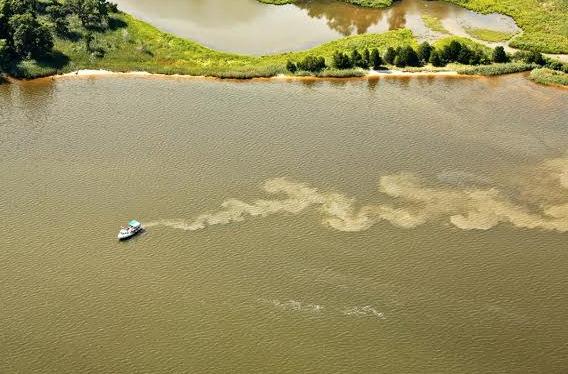Hydraulic dredging for clams in our rivers is on the rise. Many of us have witnessed the damage this practice causes.
Clamming licenses in Maryland have sharply increased over the past few years, from just eight in 2013 to over 30 in 2016, perhaps signifying a modest comeback of the soft-shell clam and reflecting the increasing popularity of clams as crabbing bait. Similar to oysters, clams are a vital filter feeder and key component in the ecological food chain. Historically, the clam population has been decimated by overharvesting and disease, and, without a Department of Natural Resources (DNR) management plan, is now at risk of another serious population downturn. Today’s clam populations mirror those of oysters, resting at only about 1 percent of historic levels.
The practice of harvesting clams with a hydraulic dredge is akin to underwater strip mining. High velocity jets of water strip away the river bottom, leaving trenches that can be two feet deep and three feet wide, while a mechanical conveyor belt attached to a long metal arm churns through the newly cut river bottom collecting clams. This action causes major damage to the river floor and irreversible damage to submerged aquatic vegetation (SAV) beds, ripping up their roots and leaving large sediment pollution plumes in its wake.
According to multiple studies, hydraulic dredging is catastrophic to SAV beds and the sediment kills oyster spat in surrounding areas. While there are regulations aimed at prohibiting hydraulic dredging in SAV beds, some dredging is allowed in and near oyster sanctuaries. Additionally, it is getting much more difficult to determine where SAV beds are located as they continually change and many large SAV beds are frequently not mapped at all, leaving them vulnerable to this destructive practice.
Hydraulic clam harvesting currently is allowed year-round and the practice is increasing without any assessment of the growing environmental damage it’s causing. Day after day, these hydraulic machines scour, scrape and gouge the river bottoms, producing thousands of pounds of sediment pollution. We think it’s time to develop a clear management plan for this valuable species, taking into consideration clam populations, their immense value to the ecosystem, the residual damage of hydraulic harvest, and the views of all stakeholders. Clams, today, represent a tiny portion of the Bay’s seafood harvest. As the demand for clams increases, we should answer some important questions before clam dredging grows into an even larger problem.
Our rivers are already listed by the Environmental Protection Agency (EPA) as impaired for sediment pollution, among other pollutants.
Our rivers are virtually choking from sediment. So, the first question we might ask is: Should we continue to allow hydraulic dredging in impaired rivers when we know it causes catastrophic SAV damage and creates large areas of sediment pollution capable of killing oyster spat and all the underwater life it chokes out? The second question might become: Are there better ways to protect and manage our natural resources, to benefit all stakeholders, while insuring a healthy and sustainable clam population?
Our rivers belong to all of us. The current hydraulic harvesting practices hurt more of us than they help.
Jeff Horstman is executive director of ShoreRivers, Inc.



Al Sikes says
Excellent questions to begin inquiry in assessing a management plan which should soon be required.
James Reihl says
I clammed for approximately 23 years. First of all the trench is only 16″-18″ deep and does fill in There have been multiple studies confirming this. Second, the clam is not at 1 percent its historic levels and neither is the oyster. I am sick and tired of going to meetings and reading the stories by misinformed reporters only so they can grab some type of headline. You are not telling the public the whole truth and apparently none of you want to. The public only believes what they read or see on TV and the manipulation by reporters goes along way. I guess when the truth is told you and other reporters will not have a job. The sediment from the run-off by the Conowingo dam has destroyed more oysters and plant life then you can imagine. But hey lets not say anything because they are a big company and a contributor to the Chesapeake Bay Foundation who has done nothing for the 40+ years they have been in business.